The Impact of Boundary Spanning on Organizational Learning:
Computational Explorations
James K. Hazy
Adelphi University, USA
Brian Tivnan
The George Washington University, USA
David Schwandt
The George Washington University, USA
Introduction
If organizations can be understood as complex adaptive systems, then social structures, even boundaries, may be emergent in nature (Marion, 1999). This is relevant to organizational learning research in the effects that boundaries have on organizational learning and outcome variables. These effects may be emergent and might be explained by locally determined interactions among agents, each unaware of emerging larger-scale patterns (Epstein & Axtell, 1996; Marion, 1999; McKelvey, 1999a, 2001; Prigogine & Stengers, 1984). Little is known about the impact of boundaries on organizational learning; even less is known about the impact that local interactions among boundary-spanning agents have on organization-level outcomes.
Organizational learning literature offers a rich vein of research supporting measurable organizational learning phenomena at the collective level (Huber, 1991; Schwandt & Marquardt, 2000). It follows from above that these phenomena may be explainable by locally determined interactions among independent agents. Because of the practical difficulties in observing boundary activity in many organizations—and the confounding variables that limit the usefulness of comparing them—it is difficult to address these questions using traditional methods. Thus, we used computational techniques to explore the relationship between boundary activity and organizational learning in 11,000 artificial organizations. The results offer computational evidence that organization-level phenomena linking boundaries, organizational learning, and collective outcomes can be observed as emergent effects of locally determined interactions: a clear sign that the dynamics of complex adaptive systems are at work.
THEORETICAL BACKGROUND
Building on the foundational theories of social structure (Durkheim, 1938; Parsons, 1951), Giddens's (1984) structuration theory, and systems theory (Katz & Kahn, 1966), organizational learning refers to those aspects of the system that enable adaptation to the environment over time (Fiol & Lyles, 1985; Hedberg, 1981; Huber, 1991; Lundberg, 1989). The organization and the environment are both instrumental in the adaptive process. By inference, therefore, the boundary between organization and environment is a critical construct. In this regard, Parsons (1951) considered the environmental interface as a critical subsystem for organizational learning (Schwandt, 1997). Hedberg (1981) referred to an organization's perceptual filter as key to importing the information needed for adaptation; and Daft and Weick (1984) saw organizations themselves as interpretive systems.
This analysis defines the organization, its environment, and its boundary by recognizing the complications inherent in characterizing these constructs (Starbuck, 1976). An organization can be considered a “system of cooperative relationships” (Parsons, 1951: 72), where the product of collective action results not from the activity of a single actor or agent, but from the “cooperation of a plurality of individual actors.” In Coase's (1937/1988) economic framework, as well as subsequent research in strategy and dynamic capabilities (Dosi et al., 1998), the firm, or organization, represents a type of collective action where coordination is by internal direction rather than commercial contract (Coase, 1937/1988). This distinction creates a sharp boundary between the organization and its environment (Dosi et al., 1998; Williamson, 1975, 1994). Our definitions are consistent with these notions and include coordinating relationships that direct the execution of tasks and resource utilization within the organization, resulting in the products of collective action.
For this analysis, an organization includes all individuals or agents who are in cooperative relationships and have the capacity (opportunity and resources) to generate products of collective action (Parsons, 1951). Agents unable to engage in such cooperative relationships are by definition outside the organization; that is, in the environment. Agents who could otherwise engage in collective action but are temporarily unable to do so are said to “temporarily exit” the organization, crossing its boundary into the environment.
The organization's boundary is a social structure marked by various social signals: for example secure access to buildings, a uniform or dress code (Giddens, 1984). Recent research has identified artifacts, or boundary objects (Brown & Duguid, 2001), that organizational members recognize as indicators of position with respect to organization boundaries (Carlile, 2002). For example, timelines and project plans serve to bound organizations temporally (Yakura, 2002) while also identifying task contingencies, member assignments, and resource allocations. The boundary structure, in our framework, has the effect of differentiating collective action from individual action.
The organization members, or agents, who cross the boundary—the boundary spanners—both represent the organization to the external world and gather and process information for the organization (Adams, 1976; Aldrich & Herker, 1977; Starbuck, 1976). As the next section describes, our interest is in the information-processing aspect of boundary spanning, and boundary spanners are the only ones that have access to information external to the organization. Thus, they face the difficult task of sampling, gathering, and disseminating new information into the organization (Weick, 1979).
Information that exists in the environment may be relevant to the individuals or agents who exist inside the organization, with respect both to the organization's cooperative relationships and to the nature and efficiency of the organization's collective action that generates product. Information in the environment changes with a certain frequency. It may also change the very nature of the competitive landscape and the best way to structure coordinating relationships for collective action (Rivkin & Siggelkow, 2002; Siggelkow, 2001; Siggelkow & Rivkin, 2003). The question is this: By what mechanism does the organization access, interpret, and act on this information?
This analysis asserts that new information is imported into the organization when boundary-spanning individuals or agents interact with individuals outside the organization to gain information. This happens during information-transfer events. When boundary-spanning agents return to the organization after interacting with outside agents in the external environment, interaction with the organization between boundary spanners and other members disseminates, or diffuses, the information within the organization. Once information has relevance to the coordination relationships necessary for collective action (Parsons, 1951), it is subsequently considered to be knowledge (Nonaka, 1994). Internal interactions thereby result in knowledge diffusion (Schwandt & Marquardt, 2000). Knowledge diffusion among agents may be based on global rules internalized by the agent: for example, more recent knowledge might always replace older knowledge. Alternatively, knowledge diffusion may involve more complex rules that are defined by the specific characteristics of the local interaction. For example, in an agent-to-agent interaction, knowledge might be transferred from the agent with higher position in the power hierarchy to the agent with lower position, regardless of the relative currency. The latter case would operate to replicate organizational beliefs or routines, sometimes at the expense of current best practice (March, 1991).
BOUNDARIES AND BOUNDARY SPANNING
Considerable research has explored the notion of organizational or firm boundaries in the context of environmental change (Afuah, 2001; Starbuck, 1976). Transaction cost economics (Williamson, 1975, 1994) suggests that boundaries balance the risks inherent in the opportunism associated with external relationships against the costs of directing internal activities constrained by bounded rationality (Afuah, 2001; Schilling & Steensma, 2002). The resource-based view of the firm (Barney, 1991; Penrose, 1959) and the knowledge-based view (Hamel & Prahalad, 1994; Makadok, 2001; Nonaka, 1994; Zander & Kogut, 1995) looked at decisions with respect to resource and technology integration across boundaries under various situations (Afuah, 2001; Schilling & Steensma, 2002). In these accounts, the organization-environment boundary is considered in the context of contractual relationships, one particularly concrete type of social structure (Giddens, 1984), whereas other research has considered boundaries as both socially constructed, in the more general sense of structuration (Giddens, 1984; Lissack, 1999; Weick, 1995), and emergent with an important temporal dimension (Richardson & Lissack, 2001).
Considerable research has also explored the nature of boundary spanning and boundary-spanning roles (Adams, 1976; Starbuck, 1976). Research in labor relations (Friedman & Podolny, 1992), banking (Tyler & Stanley, 2001), marketing (Singh & Rhoads, 1991), and research and development (Keller & Holland, 1975) has described the complex nature of these activities and their effect on the individuals involved (Johlke & Duhan, 2001; Keller & Holland, 1975; Singh & Rhoads, 1991) and on organizational outcomes (Tyler & Stanley, 2001).
Previous research has identified various types and differentiations of boundary-spanning roles and their relationships to the environment (Ancona & Caldwell, 1997; Brown & Schwab, 1984). For example, Aldrich and Herker (1977) identified two distinct functions of boundary-spanning roles: information processing and external representation of the organization to outsiders. Other researchers added additional features, such as monitoring, scanning, and gatekeeping, to the information-processing activities (Brown & Schwab, 1984). In a longitudinal study of labor negotiations, Friedman and Podolny (1992) found that over time, representation and gatekeeper roles—although often considered to be performed by a single individual—became differentiated in different individuals. Similarly, advice and trust interactions could be handled by different individuals (Friedman & Podolny, 1992). The information-processing function of boundary spanning is considered in the following analysis. Given the above research, one may reasonably assume that the agents performing information-processing boundary-spanning activities can be isolated and studied separately.
CONCEPTUAL FRAMEWORK
Figure 1 summarizes the conceptual framework. As the top row shows, we posit that boundary spanning—particularly the information-processing exchanges between the organization and the associated environment—influences organizational outcomes, but also that this effect is mediated by organizational learning. If an organization has no capacity to learn from the information it gathers (Cohen & Levinthal, 1990), the effect on outcomes will likely dampen to zero. On the other hand, effective organizational learning increases the impact of boundary spanning on outcomes. The bottom half of Figure 1 summarizes the hypothesized relationships among variables in this context. These hypotheses are described in detail in the next section, following a more detailed discussion of the conceptual framework below.
SPECIFIC FRAMEWORK FOR STUDY
We specifically address unanswered questions about the sensing and learning aspects of organizations: how new information is gathered, imported, and diffused as knowledge throughout the collective, and how these processes affect outcomes. Organizational learning research
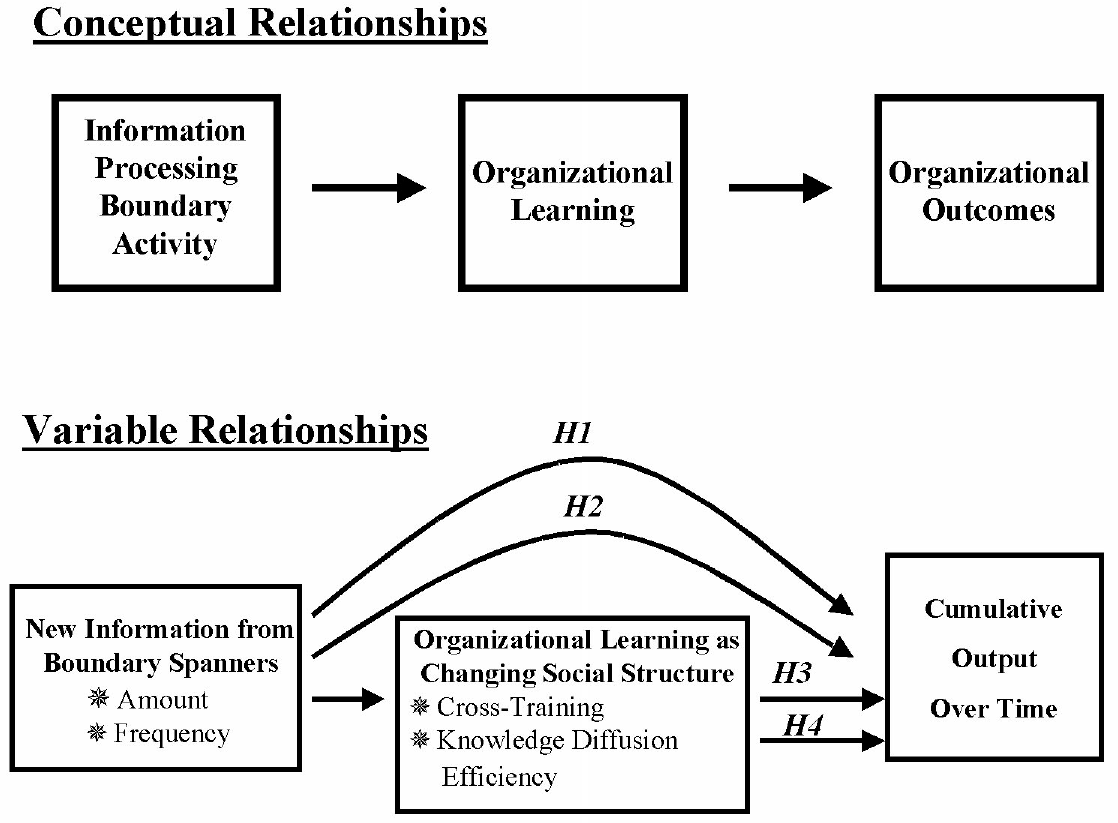
Figure 1 Conceptual framework indicating posited relationships and hypothese
(Huber, 1991; Schwandt & Marquardt, 2000; Shrivastava, 1983) has asserted that boundary-spanning agents are necessary for gathering new information to sustain an organization in turbulent environments. This information is then diffused through the organization. For this analysis, new knowledge is new information in the context of coordinating relationships and collective action; that is, new information that has relevance in an embedded network of agent, task, and resource connections.
ORGANIZATIONAL LEARNING SYSTEMS MODEL
Consistent with the systems theory approach to organizational learning, Schwandt (1997: 8) defined organizational learning as “a system of actions, actors, symbols and processes that enables an organization to transform information into valued knowledge which in turn increases its long-run adaptive capacity.” Although Schwandt's Organizational Learning Systems Model (OLSM) contains four learning action subsystems and four interchange media, we focus on the environmental interface and its medium of interchange, new information, and on the dissemination/diffusion subsystem and its medium of interchange, structuration (see Figure 2).
The environmental interface subsystem acts as the information-input mechanism for the organizational learning system (Schwandt, 1997: 9).
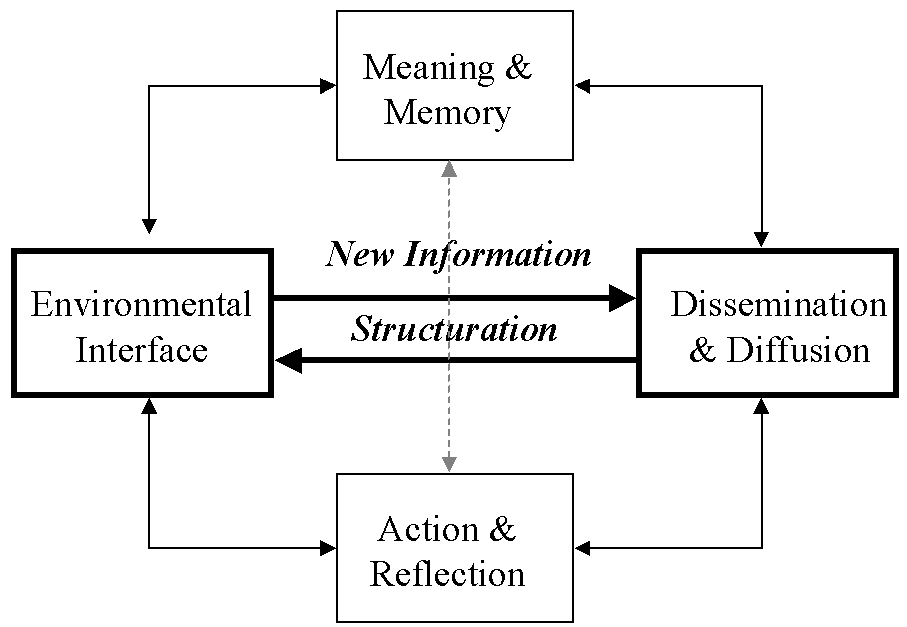
Figure 2 Focus areas in the Organizational Learning Systems Model (OLSM) Source: Schwandt, 1997
This subsystem of actions focuses externally to relate the organizational learning system to its environment and to develop the means by which it pursues different learning goals and meets changing environmental conditions. Its interchange medium is new information.
The dissemination/diffusion subsystem moves, transfers, retrieves, and captures information and knowledge for the learning system. The actions of this subsystem are characterized by their ability to meet the integrating requirements of the other learning subsystems; they include acts of communication, networking, management, coordination, and implementation supporting the norms associated with the movement of information and knowledge (Schwandt & Marquardt, 2000). Structuration (Giddens, 1984), the interchange medium, is more than a structure of the social system; it is an integration of organizational structures, roles, norms, objects, and processes that provide this dynamic quality called structuration (Schwandt & Marquardt, 2000).
The above context links boundary-spanning activity with new information gathering and knowledge diffusion. We hypothesize relationships between levels of boundary spanning, environmental turbulence, coordination of relationships among agents, and the products of collective action.
FOUR HYPOTHESES
Four hypotheses derived from organizational learning theory were tested.
THE EFFECT OF BOUNDARY SPANNERS ON ORGANIZATIONAL OUTPUT
The predominant view of research related to boundary-spanning activity and organizational learning, particularly in product development, has been that more is better (Aldrich & Herker, 1977; Carlile, 2002). However, researchers have realized that boundaries serve a purpose for coordinating internal action and isolating internal function from outside interference (Aldrich & Herker, 1977), thereby reducing the risks of opportunism (Schilling & Steensma, 2002; Williamson, 1975). Thus, one would expect that some minimal level of boundary spanning is necessary to avoid competency traps (Levinthal & March, 1993) and increasing returns to boundary spanning at low levels. At higher relative levels, however, boundaries are weakened and internal efficiency declines, so one would expect declining returns (Ancona & Caldwell, 1997; Schwandt & Marquardt, 2000). This is consistent with more general computational modeling of random networks, which demonstrates that initially there are increased returns to complexity, but that these returns diminish after a point (Kauffman, 1993).
Hypothesis 1: The number of boundary spanners in an organization (i.e., the amount of new information) has an inverted U-shaped relationship with the organization's output.
THE EFFECT OF INCREASED ENVIRONMENTAL TURBULENCE
A second critical aspect of boundary spanning is the nature of the environment, its stability, and the nature of changes within it (Aldrich & Herker, 1977; Schwandt & Marquardt, 2000). Environmental changes to which an organization may adapt can be classified broadly into two types: changes relevant to efficient activity in the existing performance landscape; and changes that alter the fitness landscape itself (Kauffman, 1993; Levinthal, 1997; Porter, 1996; Siggelkow, 2001; Siggelkow & Rivkin, 2003). Ashby (1962) described an additional, third type of environmental condition, “chaotic,” which does not promote adaptation or self-organization. Chaotic conditions, as Ashby (1962) described them, are unpredictable or seemingly random, such that an organization cannot systematically respond or organize to address them (Ashby, 1962; McKelvey, 2001).
In this analysis, environmental turbulence is defined as the frequency with which new information is introduced into the environment. Specifically, we are referring to actionable information relevant to the efficient execution of the organization's existing task structure. As the rate at which new information is introduced into the environment increases, the number of boundary spanners needed to update the knowledge stock inside the organization needs to increase, so that the organization can sustain itself (Aldrich & Herker, 1977; Schwandt & Marquardt, 2000).
Hypothesis 2: As turbulence in the environment (i.e., the frequency with which new information is introduced into the environment) increases, the inverted U-shaped relationship between the number of boundary spanners and organizational output shifts to the right, so that relatively more boundary spanners are needed to achieve an equivalent level of collective output.
THE EFFECT OF AGENT TASK ADAPTATION ON OUTPUT
To be useful, boundary spanners must bring information back to the organization and use it (Aldrich & Herker, 1977; Schwandt & Marquardt, 2000). One of the most direct ways to ensure that the information is used is to empower the boundary spanner itself to use the information gathered externally within its own community of practice to benefit collective activity (Carlile, 2002). At the organizational level of analysis, the aggregate of this empowerment effect can be interpreted as an aspect of absorptive capacity, the ability of an organization to gather and use new information (Cohen & Levinthal, 1990). As the internal complexity of the organization's task structure increases to match the environment (requisite variety), adaptation results (Ashby, 1962).
More broadly, organizational learning theory suggests that when agents are permitted to perform all tasks for which they have knowledge—defined here as agent task adaptation (agents are assumed to be able to “adapt” to the environment with respect to task assignment when new information is gathered)—organizational output increases (Schwandt & Marquardt, 2000). This is expected to remain true independent of the number of boundary spanners.
Hypothesis 3: Agent task adaptation results in increased organizational output, but does not change the inverted U-shaped relationship between boundary spanning and output. Rather, it shifts the curve upward.
THE IMPACT OF A LOCALLY DETERMINED RULE FOR KNOWLEDGE TRANSFER
The diffusion of new information and knowledge within the organization is a critical determinant of the usefulness of knowledge (Schwandt & Marquardt, 2000). This diffusion is assumed to take place in the local interactions among agents (Holland, 1995; Schwandt & Marquardt, 2000). Not all diffusion rules are equivalent.
If one assumes that the most recent knowledge is always exchanged by agents as individuals interact, then new knowledge eventually reaches all parties. If one also assumes, for simplicity, a strong positive correlation between the currency and value of knowledge—that is, no disruptive change (Christensen, 1997; Henderson & Clark, 1990) along Siggelkow's (2001) second dimension that might make more current knowledge less valuable than older knowledge—then knowledge diffusion in this context can be considered efficient.
However, if the potential exchange of knowledge is gated by the unique character of the individuals involved rather than the knowledge—by the relative power relationship or hierarchical position of the agents (Starbuck, 1976), for example—then the outcome of diffusion is less certain and may be inefficient.
The OLSM (Schwandt & Marquardt, 2000) predicts that less efficient knowledge diffusion will lead to fewer surviving organizations and lower output.
Hypothesis 4: A less efficient knowledge transfer (i.e., knowledge transfer that occurs based on the relative strength of the interacting agents rather than on the currency of knowledge being exchanged) leads to lower organizational output.
EXPERIMENTAL DESIGN AND METHODS
To test the above hypotheses, many possible scenarios must be observed to determine statistically significant trends across many organizations. It is also important to look at scenarios that are comparable, or at least at those in which differences can be adequately measured. The nature of these questions would require hundreds of samples—an impractical situation for field research. Therefore, computational simulation was selected. Further, our interest in the cumulative, organization-level effects of agent or individual-level boundary-spanning interactions made agent-based modeling a logical selection. Thus, we built an agent-based model to explicitly represent boundary-spanning activities by agents, answering the call for agent-based modeling in organizational science research (McKelvey, 1999b).
A software program was created to grow artificial organizations that included the following: agents (or persons) that were members of an organization and some that were defined to be outsiders; a habitat operationalized as a spatial grid with resources scattered randomly across it; and a time-stepping process that allowed agents to move at random, interact, and either prosper or die over a defined period of time (Epstein & Axtell, 1996).
For this research, although conceptualized as both socially constructed (Lissack, 1999; Weick, 1995) and as emergent and temporal (Richardson & Lissack, 2001), the organizational boundary is represented as an independent variable merely to facilitate analytical comparison between organizations. By manipulating the initial characteristics of this artificial organization and its inhabitants, controlling the initial conditions of others, and then watching the organization develop over time, we observed the resulting outcomes of collective action. This allowed computational experiments that would have been difficult or impractical to duplicate in the real world.
THEORETICAL BASIS FOR COMPUTATIONAL ANALYSIS
As a starting point for computational analysis, we accepted the definition of an organization often used in computational modeling (Carley & Prietula, 1994: 56), also known as the ACTS theory: “Organizations are viewed as collections of intelligent agents who are cognitively restricted, task oriented, and socially situated.” We adopted a precise description of an organization as a connected network linking persons, resources, tasks, and knowledge (Krackhardt & Carley, 1998).
Finally, each agent included a sentient intelligence mechanism that enabled it to change the network connections in its local environment based on its current network connections. Without connection to relevant knowledge, for example, the agent cannot perform its tasks. The idea is that existing network connections both constrain and enable agent actions and that these can be modified by the agent to change the dynamics of future interactions (Hazy & Tivnan, 2003).
REPRESENTING AN ORGANIZATION AS A NETWORK
Each agent was randomly assigned to only one task, and each task was assigned to only one type of resource as input. Effectively, there were I number of agents and J types of agents: one for each task type, or Tj. Like
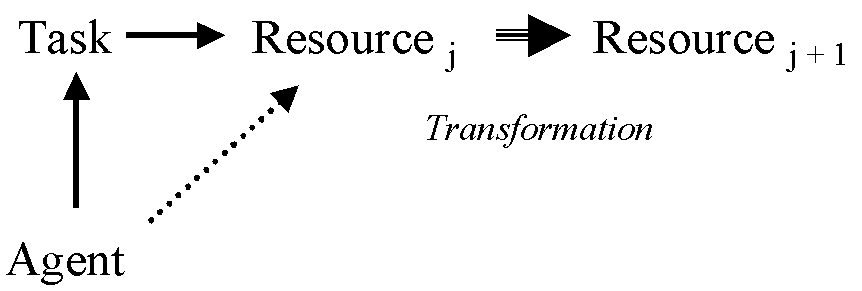
Figure 3 A representation of change to the network of resources
wise, each task, Tj, was attached to a resource, Rj, as an input and to Rj+1 as an output. As Figure 3 shows, the following actions occurred: agent Ai, which happened to be previously assigned to task Tj, moved to a space adjacent to resource Rj, enabling agent Ai to perform task Tj and thereby converting resource Rj to resource Rj+1. Thus, these actions represented a change to the network of connections among agents, tasks, and resources by the action of an agent.
THE IMPACT OF KNOWLEDGE TRANSFER AND DIFFUSION
The concept of knowledge and knowledge transfer was introduced into the above simulated organization. To produce an output from a resource input and thereby complete a task, an agent had have the knowledge relevant for the agent-task pairing. In addition, depending on the turbulence in the environment, the value of an agent's knowledge decreased over time. The consequence of this value decrease was a decline in production efficiency over time if new knowledge was not imported. Agents accumulated knowledge by interacting with other knowledge-bearing agents. Knowledge was refreshed with new generations of knowledge by interaction with other member and outsider agents bearing more current knowledge. In this artificial organization, new information that was potentially useful in creating new knowledge was always introduced outside the organization's boundary.
With respect to agent learning capacity, any agent could carry (i.e., be linked to) and transfer any and all knowledge types; but each knowledge type was linked to only one task type. Therefore, only one knowledge type was useful to a particular agent in the base case (i.e., the knowledge relevant to its task type). Outsider agents acted as carriers of the latest information and refreshed the knowledge of the member agents with whom they interacted. Outsider agents performed no organizational tasks and consumed no organizational resources.
A network representation of this condition is shown in Figure 4. An agent's acquisition of knowledge causes a new connection between agent and task to be created, so that appropriate random resource connections can begin to trigger resource transformations. The following section describes our efforts to validate the modeling approach discussed above.

Figure 4 Network representation of knowledge connection impact
VALIDATING THE MODEL
To ensure that the simulation model approximated observed behavior of organizations along the dimensions of interest, we identified stylized facts for comparison. Our hypotheses involved the output level or relative fitness of business organizations producing output by performing a series of distinct yet interdependent tasks, a characteristic of nearly decomposable systems (Simon, 1962). These tasks were assumed to use resources and belong to a value chain. Tasks used raw materials and converted them into work-in-progress inventory and then to final outputs. We therefore used empirically derived and supported theoretical constructs as our stylized facts.
First, as expected, we observed the production of output along a series of contingent tasks, not one of which would produce the final product. Thus we replicated the value chain—a stylized fact set that we sought to simulate as partial validation of our model (Porter, 1980, 1985; Sterman, 2000). Within the simulated environment, resources were transformed at various stages of value creation by the action of the agents with the appropriate task assignment and knowledge. Agents consumed energy with each step, and the collective's energy reserve was replenished for agents only when the collective goal was produced—precisely the outcome that one would expect in a value chain (Porter, 1985). Failure to continually achieve this collective goal—that is, to perform all of the tasks along the value chain—led to the death of individual agents and, eventually, to the end of the collective. As Figure 5 indicates, J independent tasks each transformed one resource, Rj, in the value chain into the next resource, Rj+1. When any agent that was connected to task Tj became connected to resource Rj by random movement, resource Rj was transformed into Rj+1.

Figure 5 The value chain model. Source: Porter, 1980
The above “production process” continued until the completion of final task TJ, wherein a final product, RJ+1, was created and a payoff function was exercised. This payoff function added energy to the appropriate agents and provided new raw resource, R1, to reinitiate the production process. In this way, the collective could sustain itself and individual agents could survive by benefiting from collective success. Thus, the value chain was effectively simulated.
Second, we sought to simulate collective activity and collective reward, as distinct from individual activity and reward. Thus, we chose to use results from team effectiveness research, such that reward interdependence, task interdependence, and potency could be observed as predictors of successful collective action (Shea & Guzzo, 1985). For validation, results were compared with these studies to demonstrate that the model does indeed simulate collective action: task interdependence, reward interdependence, and collective potency (Lestor et al., 2002; Shea & Guzzo, 1985). Thus, in the base case, no agent could perform all of the tasks itself, and all tasks had to be completed for any reward to be distributed. Also, resources, tasks, and relevant knowledge were available to agents, thereby simulating the collective's ability, or “potency,” to execute successfully (Shea & Guzzo, 1985). Because no one agent could produce the final good independently, collective action and collective success were both necessary for individual survival.
Finally, because the environment was changing, empirical results and organizational theory predicted that without boundary spanners, the organization would eventually fail to respond to the environment and then dissolve. We therefore compare our results at this extreme with the observed decline of organizations that fail to gather new information from the environment (De Vries, 1999). Few organizations were able to sustain themselves when low levels of boundary spanning were observed, further supporting the model's validity, as we will demonstrate by describing a few representative model runs.
REPRESENTATIVE RUNS OF THE BASELINE AGENT-BASED MODEL
To set the context for the presentation of results and the subsequent discussion, this section describes the model behavior using results from three different representative model runs—arbitrarily identified as Model Run 1, Model Run 2, and Model Run 3. Each model run resulted from the same set of parametric conditions: the number of boundary spanners was set to 40 of the 100 organizational members, and the environmental turbulence interval was set to 15; that is, new information was introduced into the environment every 15 days. Additionally, these model runs simulate an egalitarian organizational structure (i.e., given that a payoff occurs, all agents within a particular organization share equally in that payoff).
Although these parametric conditions remained constant in each of the three representative examples, Figures 6 through 8 illustrate that dramatically different trajectories (or outcomes) resulted from each run. Figure 6 depicts the aggregate organizational production for each of the three organizations in which the production rates (i.e., the slope of the respective lines) do not seem to differ dramatically. Although this particular graph does not convey any information on the actual payoff for the production, intervals with a slope of zero and, therefore, no production (e.g., for Model Run 3, see vertical lines in Figure 6, indicating the periods beginning at approximately time 1300 and 1750) depict periods when the organization experienced constrained resources.
Figure 7 depicts the average agent energy for each time step. Average agent energy provides a metric for approximating the available slack resources that an organization could dedicate to boundary-spanning activities of exploration. Since each agent expended one unit of energy in each time step, average agent energy decreased by one in any time step in which agents did not receive any payoff for production.
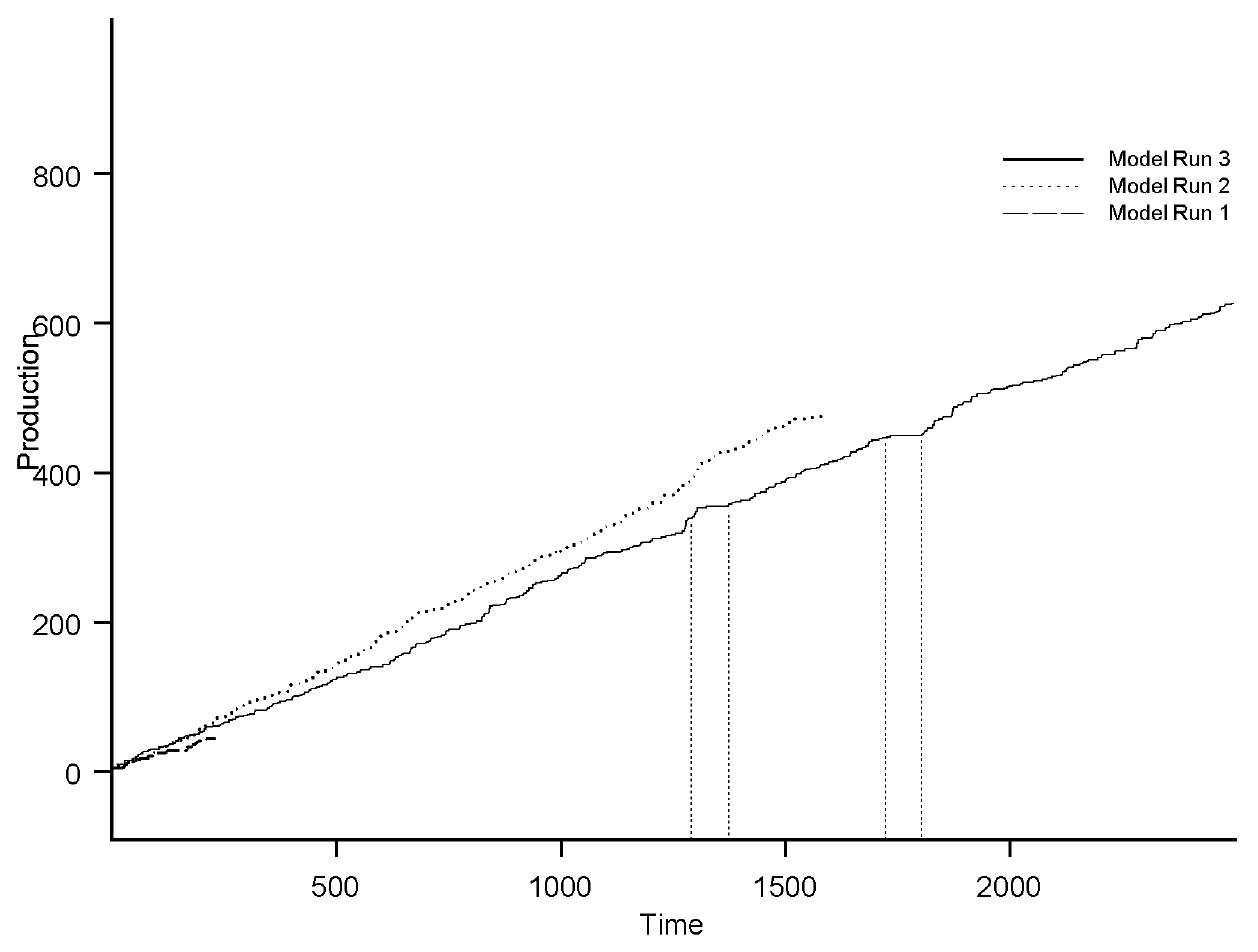
Figure 6 Production over time in three representative model runs
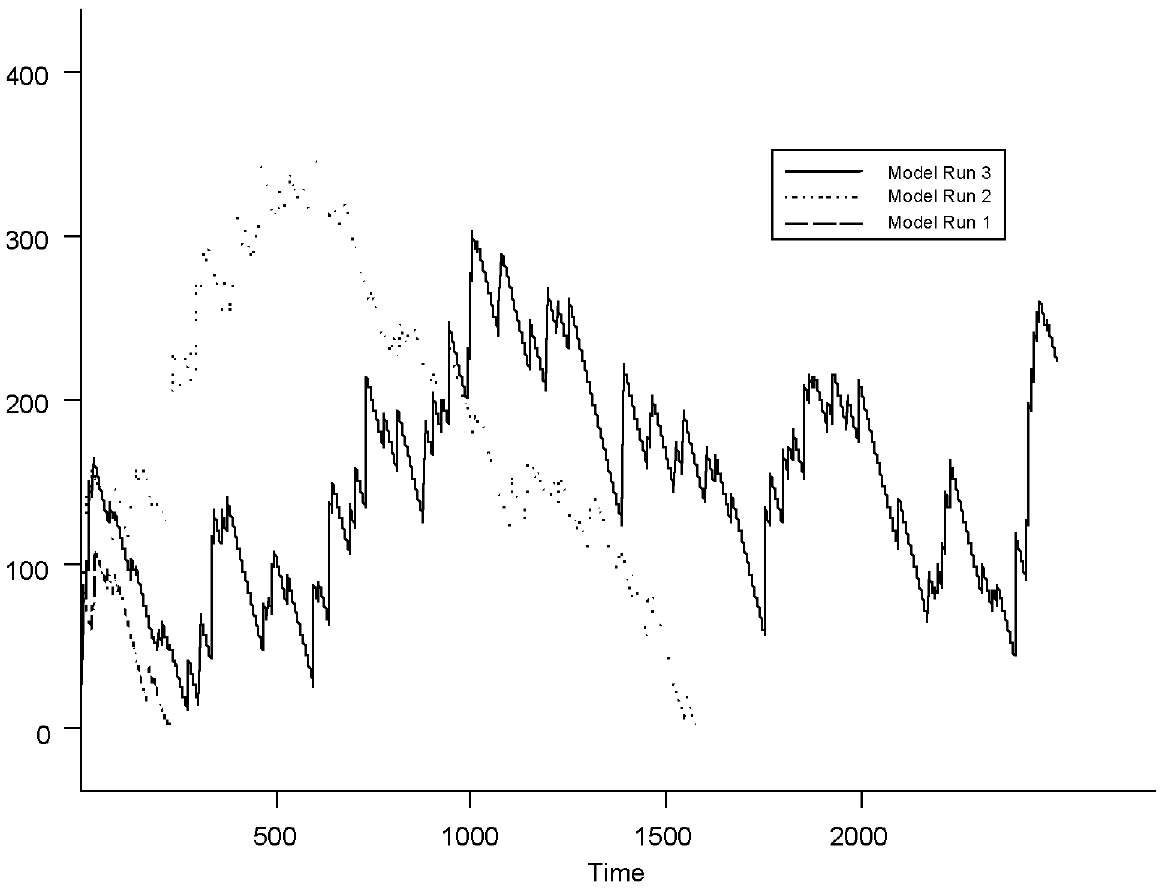
Figure 7 Average agent energy over time in three representative model runs
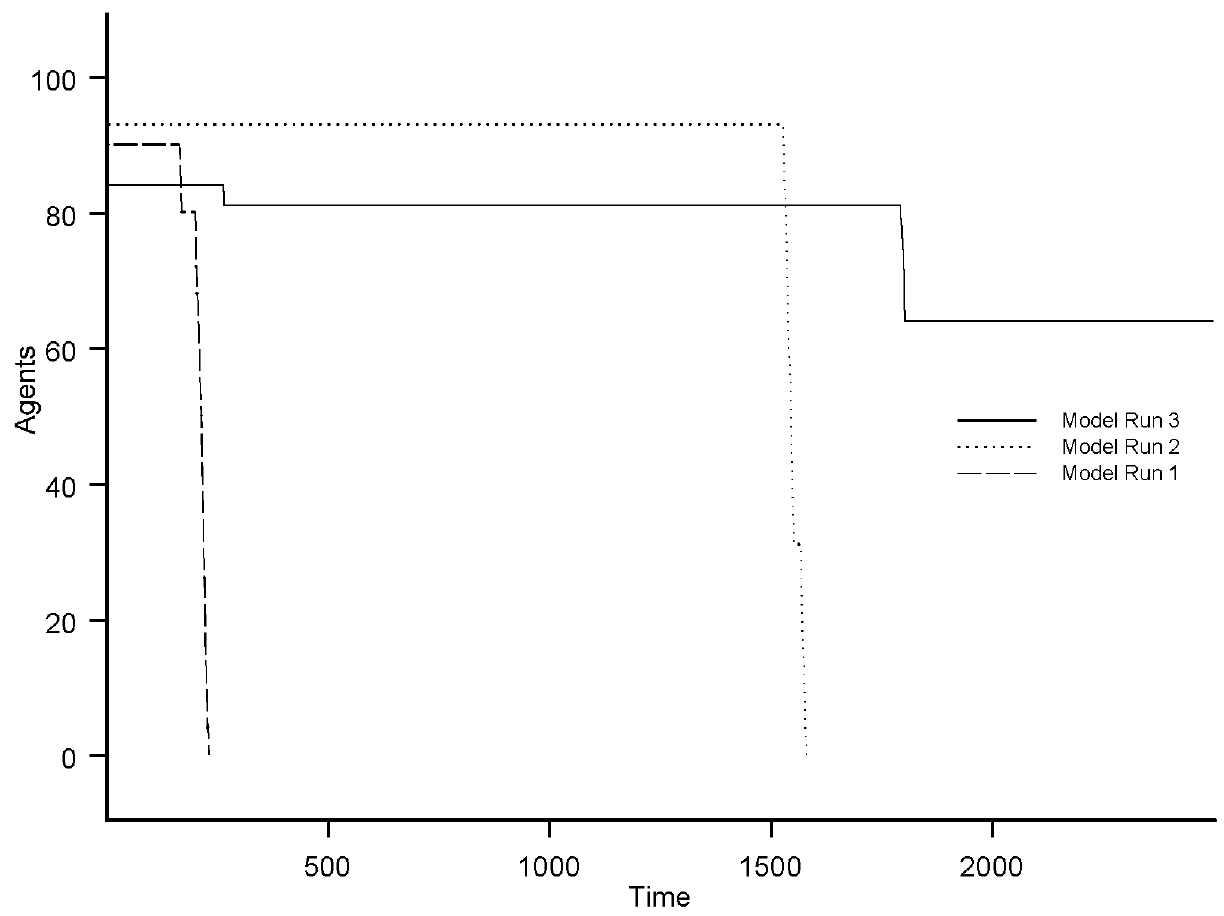
Figure 8 Number of surviving agents over time in three representative model runs
Finally, Figure 8 depicts the number of surviving agents (from the original 100 agents) within each organization. When an agent's energy dropped to zero, that agent could no longer contribute to organizational performance and was subsequently removed from the organization. Removed agents could not be reinstated (e.g., if, due to constrained resources, an organization lays off an employee without an option for recall). This captured the interdependency between an agent and its organization: the “potency” of an organization is determined by both the capabilities of its agents and the resources provided to the agents by the organization (Shea & Guzzo, 1985; e.g., fewer surviving agents performed less boundary spanning and potentially produced fewer resources that the organization could distribute to sustain agents in future time steps).
Using Figures 6 through 8, we will briefly discuss some observed differences between the three representative model runs. The organization represented in Model Run 1 began production immediately, but at a slightly lower rate than the other two organizations. This resulted in fewer slack resources with which to explore and increase absorptive capacity. The organization dissolves rather quickly (by time 233) in a result analogous to the “liability of newness” (Freeman et al., 1983; Stinchcombe, 1965). The agents never established a sustainable production environment.
The organization represented in Model Run 2 had the highest production rate and subsequently enjoyed an extended period of strong production performance. By time step 500 it possessed an abundance of slack resources by implementing an apparently successful exploitation focus (March, 1991). However, due to a lack of boundary-spanning activity, it found itself misaligned with the changing environmental conditions—analogous to a competency trap (Levinthal & March, 1993; Levitt & March, 1988)—as its aggressive production went into inventory rather than being sold. Because it did not sell its production at a profit, it ceased to yield the resources necessary to sustain its agents and itself. It disintegrated at time 1582 with no active agents.
In contrast, the organization represented by Model Run 3 adopted a balanced exploitation/exploration focus via its boundary-spanning activity. At time 1300 and 1750, agent exploration activity temporarily created a resource-constrained environment when no production occurred and that led to some agent attrition at time 1800. Unlike in Model Run 2, however, when the organization in Model Run 3 resumed its production, it increased its absorptive capacity in such a manner as to sustain itself in its current state as well as to maintain its awareness of environmental conditions.
Having confirmed the model's validity with respect to the selected stylized facts and explored in detail a few representative model runs, we performed virtual experiments to test the hypotheses.
RESULTS AND ANALYSIS
For each scenario described, at least 100 runs were made with identical initial conditions. Agents moved at random, so agent-to-agent and agent-to-resource interactions were random. Because the interactions of agents with the network were stochastic, the outcome of a particular run could not be predicted or replicated.
IMPACT OF BOUNDARY SPANNERS (HYPOTHESIS 1)
To test Hypothesis 1, we designed a computational experiment that varied the number of agents permitted to cross the boundary of the organization in search of new information. We assumed the same moderate level of environmental turbulence (i.e., new information was introduced into the environment every 15 time steps) for all runs, and all other aspects of the model were identical when the model was initialized. The model was then allowed to run until one of the following two events occurred: all agents had expired; or a user-defined number of time steps had passed.
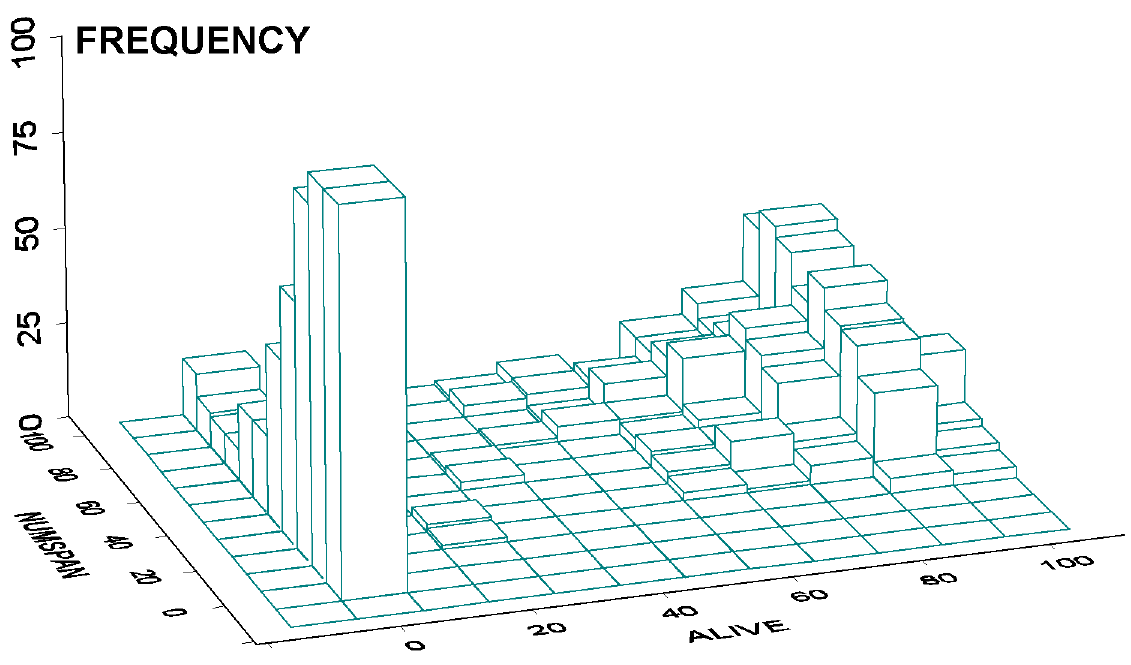
Figure 9 Three-dimensional histogram of agents alive at the end of the run versus number of boundary spanners (Hypothesis 1)
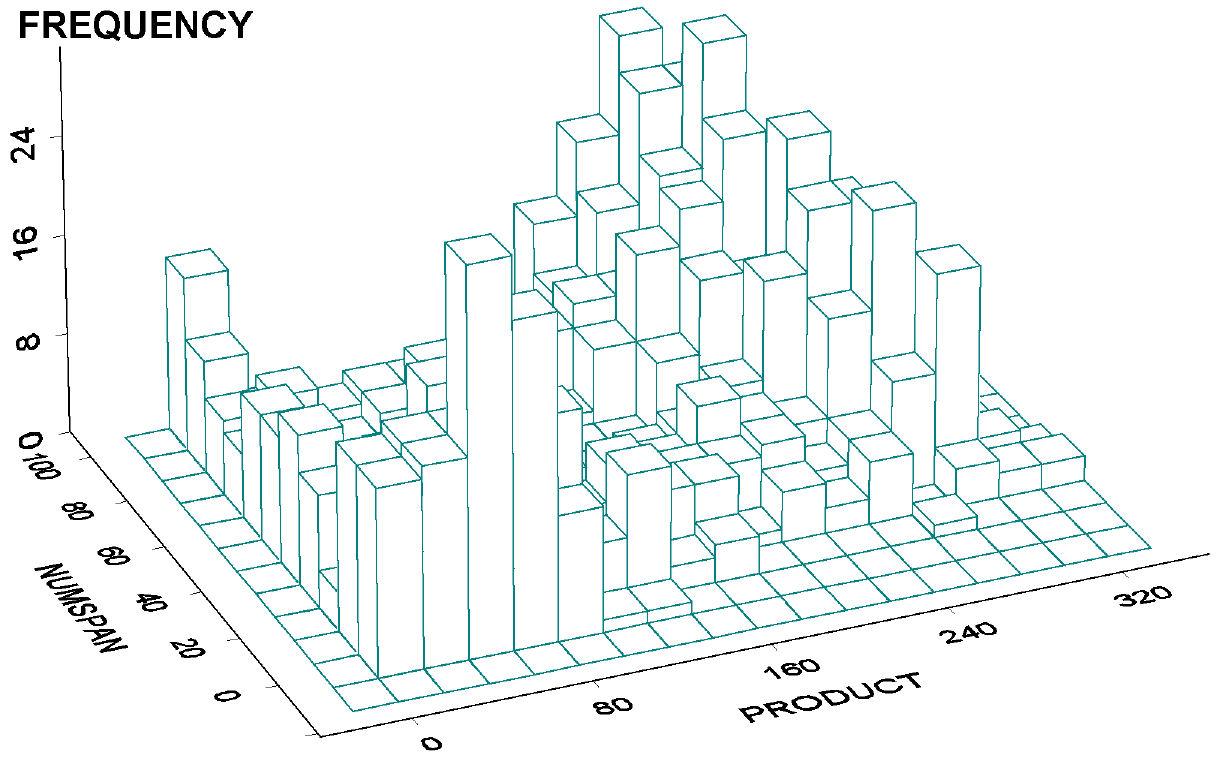
Figure 10 Three-dimensional histogram of total product output versus number of boundary spanners with turbulence equal to 15 (Hypothesis 1)
To test the hypothesis, we looked at 11 different boundary-spanner scenarios, each with 100 identical runs. The only difference between scenarios was the number of agents designated as boundary spanners. We set the number of boundary spanners in increments of 10, starting with 0 and proceeding to 100 member agents, for each scenario.
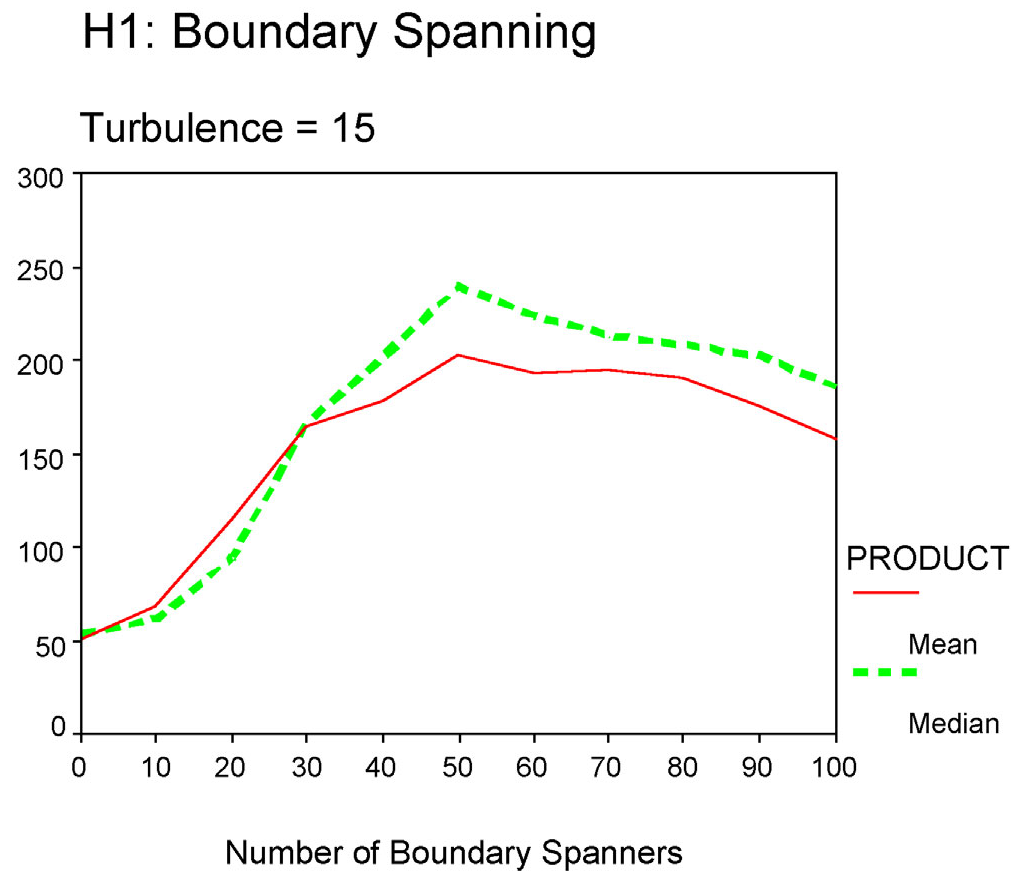
Figure 11 Output with varying numbers of boundary spanners (out of 100) (Hypothesis 1)
Figure 9 shows the frequency distribution of 1,100 model runs (i.e., 100 runs for each of the 11 scenarios of number of boundary spanners) for each combination of number of agents that remained alive (ALIVE) at the end of the run and number of spanners (NUMSPAN) allowed. The surface has two relative peaks. With relatively few boundary spanners, few or no agents survived until the end of the run. As the number of boundary spanners increased, more agents survived with increasing frequency.
As depicted in Figure 10, this same two-peak pattern appears when the total organizational output (PRODUCT) was plotted in a histogram with the number of boundary spanners (NUMSPAN). A wide dispersion in output can be seen across different runs of the model.
To test the hypothesis directly, we looked at central tendency measures of total output across 100 runs in each scenario. Looking at both the mean and median for each scenario in Figure 11, one can see differences in organizational output related to the number of boundary spanners. Typically (as determined by both mean and median), organizational production increased as the number of boundary spanners increased, up to a point, and then gradually declined. In all cases, the level of environmental turbulence in the model was constant.
These results support Hypothesis 1. Under the idealized conditions of these artificial organizations, boundary spanners were increasingly associated with collective survival and output, up to a point, and then the marginal value of incremental boundary-spanning activity declined.
IMPACT OF ENVIRONMENTAL TURBULENCE (HYPOTHESIS 2)
To test Hypothesis 2, we repeated the runs for the first hypothesis but varied the frequency with which new information was introduced into the environment. This frequency, defined as environmental turbulence, represents the speed at which the environment is changing in ways relevant to the organization's task structure. An example would be how often new generations of productivity-enhancing software are released by relevant software vendors. A lower value for environmental turbulence implies more frequent introductions of new information (in the example, software releases) and thus faster change in the industry.
In this analysis, five values were set for environmental turbulence: 5, 10, 15, 20, and 25. In other words, in the various scenarios a new generation of information was available in the environment after each count of 5, 10, 15, 20, or 25 time steps, with each time step simulating a business day. Eleven scenarios (varying the amount of boundary spanners from 0 to 100 in increments of 10) were run for each value of turbulence, making a total of 55 scenarios of 100 runs each to test this hypothesis. (We had previously verified that 100 model runs with identical parametric sets allowed for statistical convergence.) Thus, this analysis involved 5,500 artificial organizations evolving under identical initial conditions (except as described).
As Figure 12 shows, looking at the mean of each scenario reveals differences in outcomes related to the level of environmental turbulence assumed. Typically, organizational production increased as the number of boundary spanners increased, up to a point, and then gradually declined. A faster pace of change in the environment implied a sharper and quicker change in state from low producing to high producing. Interestingly, after rising to a maximum, mean organizational output declined along similar curves regardless of the level of environmental turbulence. Table 1 shows that the differences in the mean are statistically significant (level of significance, a = 0.05) for lower numbers of boundary spanners.
As with Hypothesis 1, aggregate analysis does not tell the full story. When the product output frequency plots in a stable environment (see
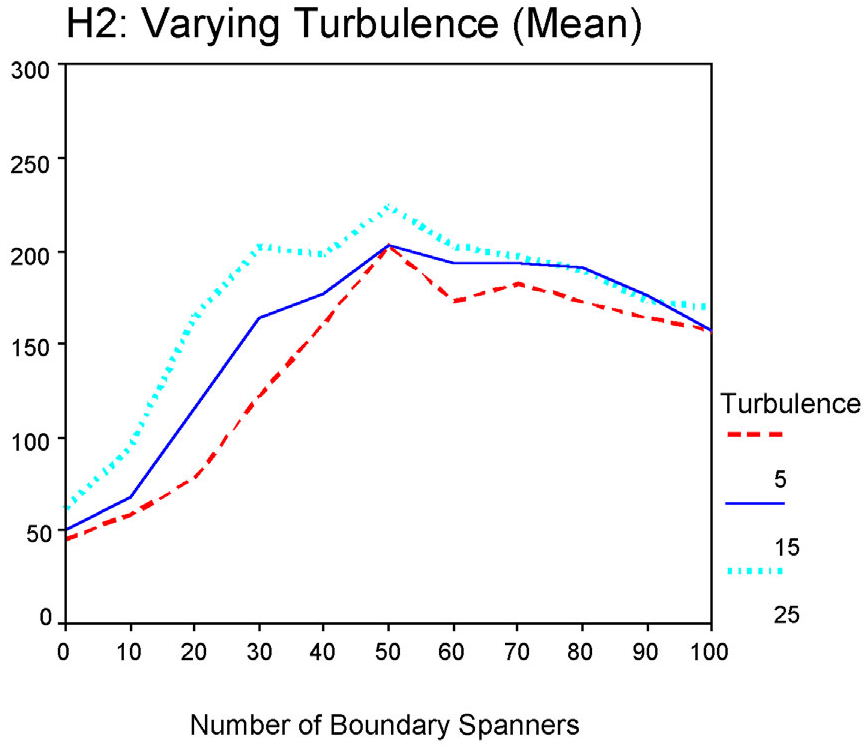
Figure 12 Mean values of output at varying environmental turbulence levels. A lower turbulence number means that new information is introduced into the environment more frequently (Hypothesis 2)
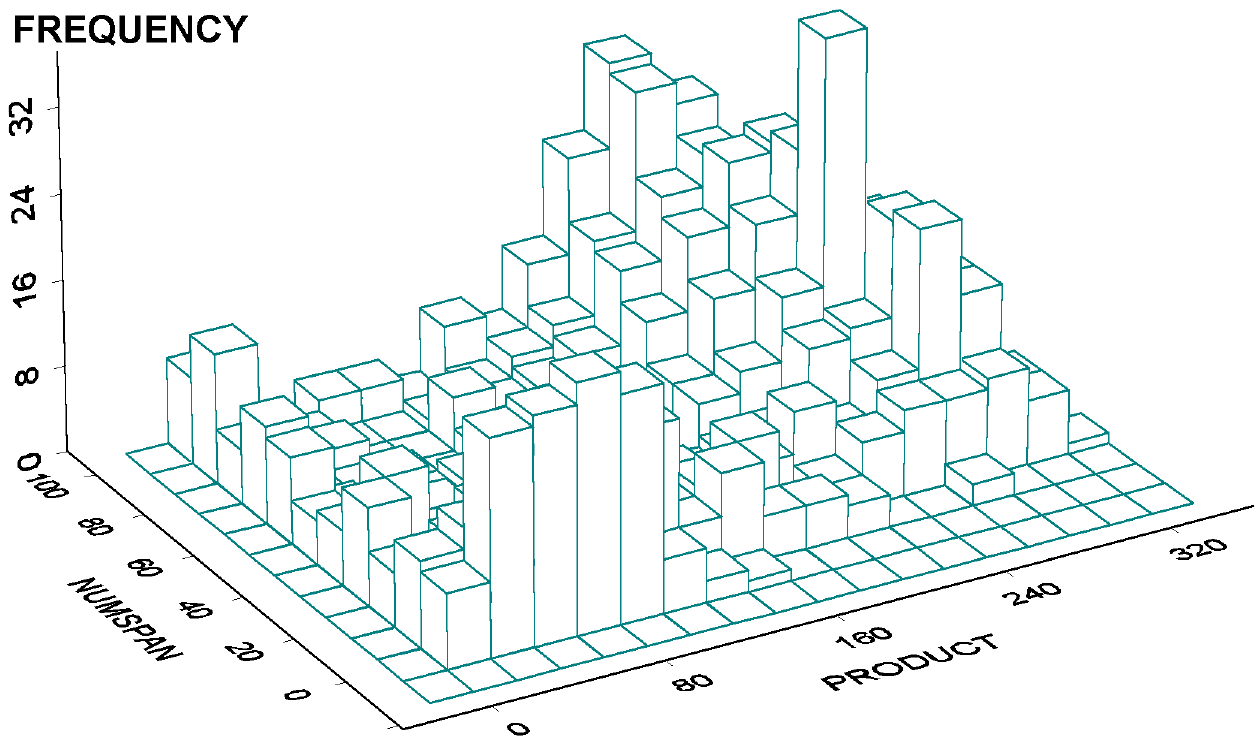
Figure 13 Stable market. Three-dimensional histogram of total product output versus number of boundary spanners when new information is introduction into the environment every 25 time steps (Hypothesis 2)
| ANOVA | ||||||
| PRODUCT | ||||||
| NUMSPAN | Sum of Squares | df | Mean Square | F | Sig. | |
| 0 | Between Groups | 24065.772 | 4 | 6016.443 | 8.73040207 | 0.000 |
| Within Groups | 341122.81 | 495 | 689.13699 | |||
| Total | 365188.582 | 499 | ||||
| 10 | Between Groups | 97187.14 | 4 | 24296.785 | 12.2656489 | 0.000 |
| Within Groups | 980535.86 | 495 | 1980.88053 | |||
| Total | 1077723 | 499 | ||||
| 20 | Between Groups | 434704.932 | 4 | 108676.233 | 17.2125432 | 0.000 |
| Within Groups | 3125321.73 | 495 | 6313.78127 | |||
| Total | 3560026.662 | 499 | ||||
| 30 | Between Groups | 456271.668 | 4 | 114067.917 | 12.3180391 | 0.000 |
| Within Groups | 4583815.54 | 495 | 9260.23341 | |||
| Total | 5040087.208 | 499 | ||||
| 40 | Between Groups | 117087.52 | 4 | 29271.88 | 3.0632939 | 0.016 |
| Within Groups | 4730065.43 | 495 | 9555.68774 | |||
| Total | 4847152.95 | 499 | ||||
| 50 | Between Groups | 78014.268 | 4 | 19503.567 | 2.56141888 | 0.038 |
| Within Groups | 3769108.49 | 495 | 7614.36059 | |||
| Total | 3847122.758 | 499 | ||||
| 60 | Between Groups | 65842.388 | 4 | 16460.597 | 2.17626673 | 0.071 |
| Within Groups | 3744024.29 | 495 | 7563.68543 | |||
| Total | 3809866.678 | 499 | ||||
| 70 | Between Groups | 19421.828 | 4 | 4855.457 | 0.88514003 | 0.473 |
| Within Groups | 2715334.45 | 495 | 5485.52414 | |||
| Total | 2734756.278 | 499 | ||||
| 80 | Between Groups | 24435.332 | 4 | 6108.833 | 1.17444211 | 0.321 |
| Within Groups | 2574730.85 | 495 | 5201.47646 | |||
| Total | 2599166.182 | 499 | ||||
| 90 | Between Groups | 7948.66 | 4 | 1987.165 | 0.3776026 | 0.825 |
| Within Groups | 2604978.54 | 495 | 5262.58291 | |||
| Total | 2612927.2 | 499 | ||||
| 100 | Between Groups | 15225.612 | 4 | 3806.403 | 0.77077596 | 0.545 |
| Within Groups | 2444509.93 | 495 | 4938.4039 | |||
| Total | 2459735.542 | 499 | ||||
Table 1 Results of Hypothesis 2 varying turbulence
Figure 13) were compared with those of a turbulent environment (see Figure 14), the two-peak, feast-or-famine nature of the outcome was evident. More rapid change in the environment increased the sharpness of transition between the frequency peaks.
These results partially support Hypothesis 2. As expected, the mean value of output is lower in more turbulent environments than in less turbulent environments, but this relationship only holds with relatively few boundary spanners. Once approximately 60 agents are boundary spanners, the mean difference in organizational output is no longer statistically significant among various levels of change in the environment.
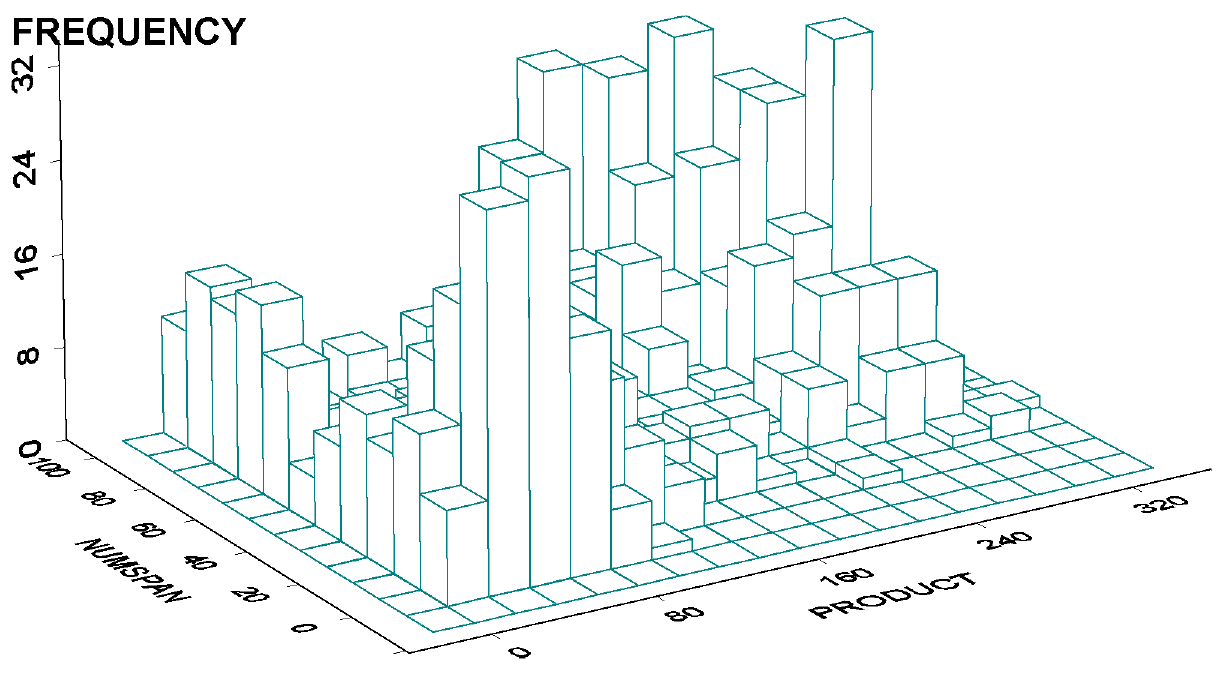
Figure 14 Turbulent market. Three-dimensional histogram of total product output versus number of boundary spanners when new information is introduced into the environment every five time steps (Hypothesis 2)
IMPACT OF AGENT TASK ADAPTATION (HYPOTHESIS 3)
To test Hypothesis 3, we designed a computational experiment permitting agent task adaptation. Agents that became linked to new knowledge appropriate to a task to which they were not assigned could, with 100 percent probability, self-assign the relevant task for execution in future time steps. This assumption increased the number of agents able to transform a particular type of resource into the next resource in the value chain. We looked at 5,500 organizations grouped into 55 scenarios by varying the number of boundary spanners and the level of environmental turbulence for each of the two conditions (i.e., agent task adaptation and no agent task adaptation).
As Figure 15 overleaf shows, when the mean values of various scenarios are plotted against the number of boundary spanners, the curves have the same general shape as in Hypothesis 2. However, with agent task adaptation, production output is higher for each boundary spanner/turbulence scenario. An additional result is that all of the curves are skewed to the left; that is, fewer boundary spanners are needed to reach a higher level of output performance when agent task adaptation is allowed. This indicates that the marginal value of boundary-spanning activity peaks at a diminished level with agent task adaptation.
As one can see in Figure 16, the histogram of output versus number of spanners in a fast-changing environment—specifically, new information introduced into the environment very frequently (i.e., every five time steps)—the same feast or famine results described in earlier results appear here also, this time with much higher output. Agent task adaptation improves output but clearly doesn't guarantee survival.
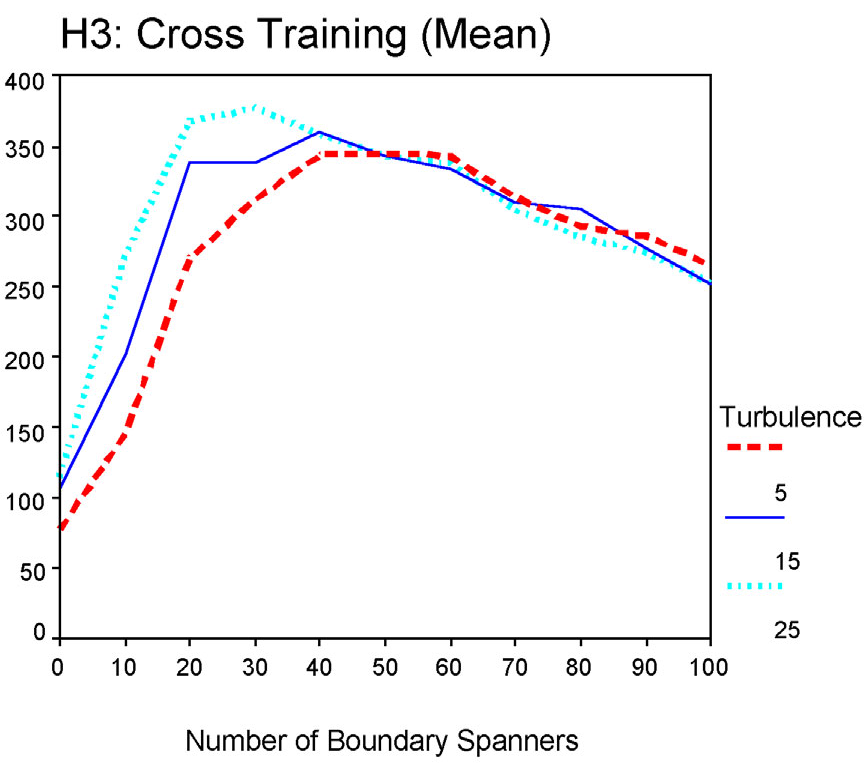
Figure 15 Mean values for various levels of turbulence with agent task adaptation (Hypothesis 3)
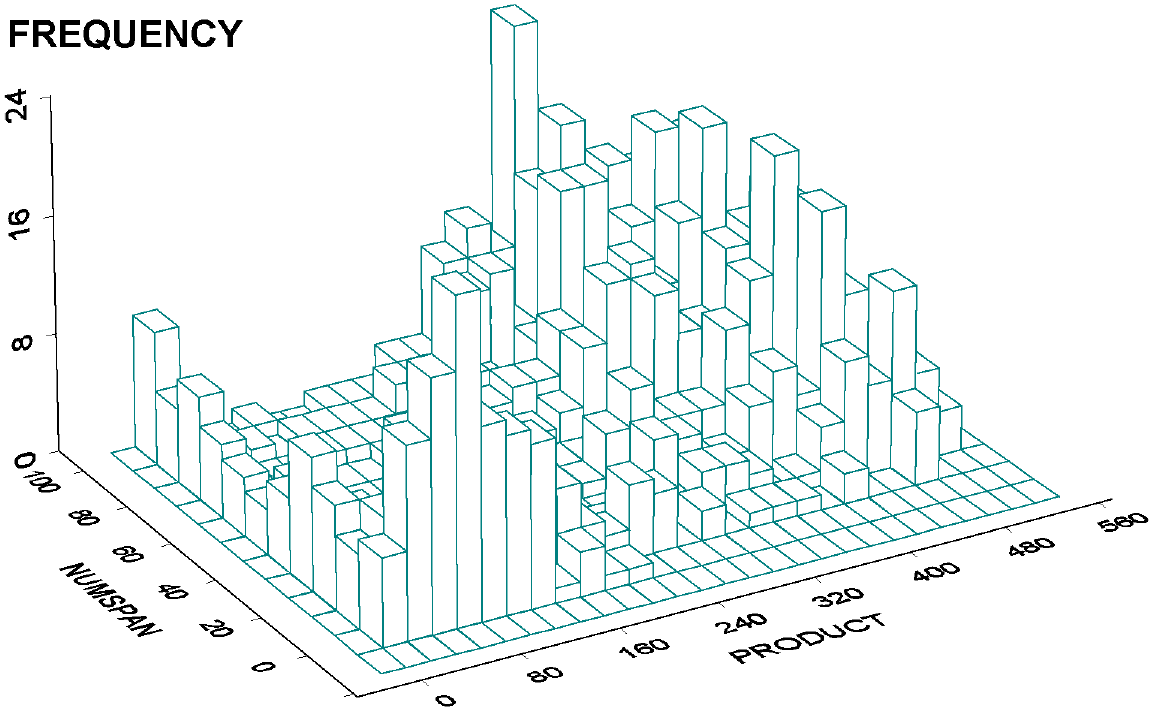
Figure 16 Three-dimensional histogram of total product output versus number of boundary spanners with agent task adaptation with turbulence equal to 5 (Hypothesis 3)
| ANOVA | |||||||
| OrgProd | |||||||
| Turbulence | NUMSPAN | Sum of Squares | df | Mean Square | F | Sig. | |
| 15 | 0 | Between Groups | 156128.72 | 1 | 156128.72 | 101.316 | 0 |
| Within Groups | 305120.96 | 198 | 1541.015 | ||||
| Total | 461249.68 | 199 | |||||
| 10 | Between Groups | 894185.645 | 1 | 894185.645 | 81.677 | 0 | |
| Within Groups | 2167670.55 | 198 | 10947.831 | ||||
| Total | 3061856.195 | 199 | |||||
| 20 | Between Groups | 2502755.645 | 1 | 2502755.645 | 156.738 | 0 | |
| Within Groups | 3161616.11 | 198 | 15967.758 | ||||
| Total | 5664371.755 | 199 | |||||
| 30 | Between Groups | 1513974.005 | 1 | 1513974.005 | 95.191 | 0 | |
| Within Groups | 3149112.59 | 198 | 15904.609 | ||||
| Total | 4663086.595 | 199 | |||||
| 40 | Between Groups | 1642759.38 | 1 | 1642759.38 | 154.444 | 0 | |
| Within Groups | 2106048.12 | 198 | 10636.607 | ||||
| Total | 3748807.5 | 199 | |||||
| 50 | Between Groups | 987855.68 | 1 | 987855.68 | 99.157 | 0 | |
| Within Groups | 1972588.32 | 198 | 9962.567 | ||||
| Total | 2960444 | 199 | |||||
| 60 | Between Groups | 961191.125 | 1 | 961191.125 | 103.299 | 0 | |
| Within Groups | 1842377.43 | 198 | 9304.937 | ||||
| Total | 2803568.555 | 199 | |||||
| 70 | Between Groups | 670250.42 | 1 | 670250.42 | 100.326 | 0 | |
| Within Groups | 1322787.08 | 198 | 6680.743 | ||||
| Total | 1993037.5 | 199 | |||||
| 80 | Between Groups | 642411.125 | 1 | 642411.125 | 106.839 | 0 | |
| Within Groups | 1190550.83 | 198 | 6012.883 | ||||
| Total | 1832961.955 | 199 | |||||
| 90 | Between Groups | 517449.645 | 1 | 517449.645 | 72.067 | 0 | |
| Within Groups | 1421664.75 | 198 | 7180.125 | ||||
| Total | 1939114.395 | 199 | |||||
| 100 | Between Groups | 458498.88 | 1 | 458498.88 | 53.991 | 0 | |
| Within Groups | 1681435.12 | 198 | 8492.097 | ||||
| Total | 2139934 | 199 | |||||
Table 2 Results for hypothesis 2 testing
Table 2 compares the agent task adaptation scenarios described above with the scenarios developed to test Hypothesis 2 (no agent task adaptation) for the case where change in the environment occurs every 15 time steps. In every comparison there is a statistically significant difference in organizational output (a = 0.05) between agent task adaptation and no agent task adaptation. Although not shown, the same holds true for the cases when new information is introduced into the environment every 5, 10, 20, and 25 time steps.
These results support Hypothesis 3. Agent task adaptation increases output regardless of how frequently new information is introduced into the environment.
IMPACT OF LOCALLY DETERMINED KNOWLEDGE TRANSFER (HYPOTHESIS 4)
To test Hypothesis 4, we designed a computational experiment comparing different rules governing knowledge diffusion at the interaction level. In all prior scenarios, knowledge was diffused in local agent-to-agent interactions based on the rule that old knowledge was always replaced with more current knowledge. Because the payoff function assumes that new knowledge is always better than old knowledge, this is the efficient case. Here we tested the effect when knowledge diffusion occurs based on the relative strength of agents. When two agents interacted, the agent with the most energy, the stronger of the two, transferred knowledge to the other agent. This created a scenario where agents did not have perfect information about the currency of knowledge, but instead exchanged knowledge based on the relative power or strength of the two agents.
Figure 17 shows that the two-peak pattern persisted, but with a lower output when compared with the results from Hypothesis 3. As Figure 18 shows, these observations were also borne out when the mean values of each scenario were compared. The differences were statistically significant in the range between 10 and 40 boundary spanners; that is, up to the point where the marginal value of the boundary-spanning activity peaks, but not beyond this point, where the marginal value begins to diminish.
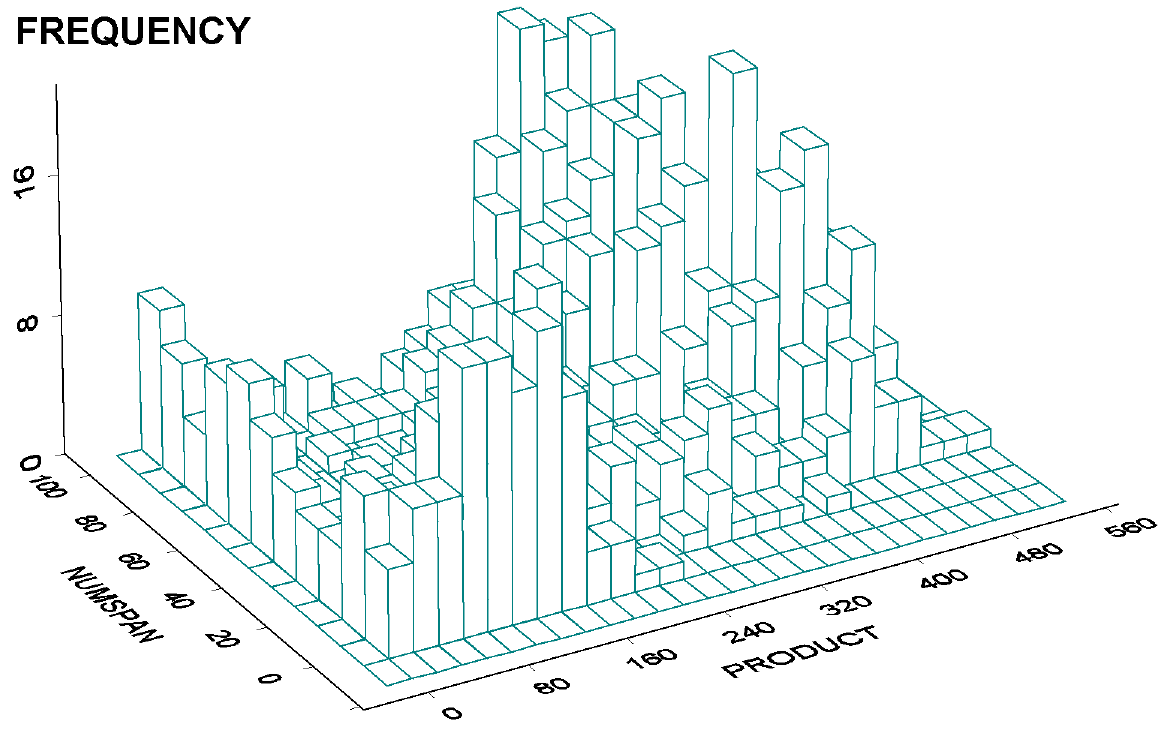
Figure 17 Three-dimensional histogram of total product output versus number of boundary spanners with agent task adaptation with turbulence equal to 15 (Hypothesis 4)
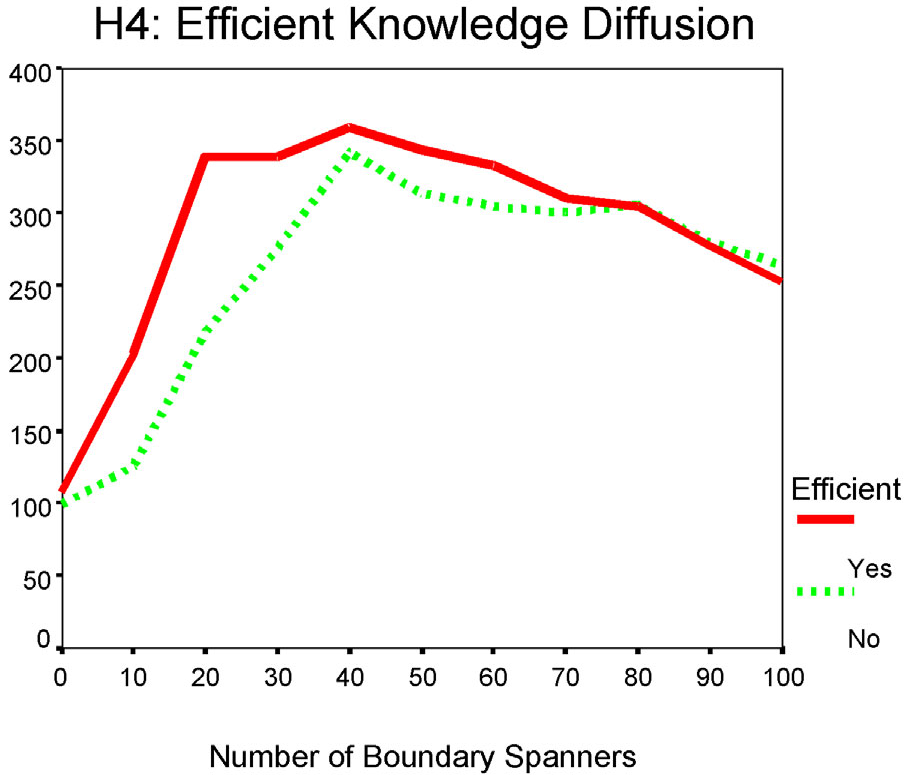
Figure 18 Comparison of mean values with perfect knowledge diffusion (Efficient Yes) versus locally determined knowledge diffusion (Efficient No) assuming agent task adaptation with turbulence equal to 15 (Hypothesis 4)
These results support Hypothesis 4. In the interval between 10 and 40 boundary spanners, where the distinction between feast and famine was most evident, the efficiency of knowledge diffusion was a predictor of success.
DISCUSSION AND CONCLUSION
FINDINGS
To study the relationship between boundary spanning, organizational learning, and organizational outcomes, we built an agent-based model and observed more than 11,000 artificial organizations. The model was validated by comparing the task-and-reward structure in the artificial organizations with empirically observed organizational structures: particularly the value chain (Porter, 1985) and group task interdependency structures (Shea & Guzzo, 1985). We then tested hypotheses to determine the nature of the relationships between the environmental change, boundary spanning, organizational learning, and organizational outcomes.
EFFECT OF BOUNDARY SPANNING ON COLLECTIVE FITNESS
Support for Hypothesis 1 implies that the amount of boundary spanning in an organization affects important organization-level outcomes such as agent survival levels and collective production. Importantly, the inverted U-shaped curve implies a complex relationship between the organization and the environment.
In particular, we demonstrated the importance and impact of boundary-spanning agents in social systems. Without an adequate number of boundary spanners, all agents died and the organization was unable to sustain itself. We further found a nonlinear relationship between the number of boundary spanners in an organization and output: too much boundary spanning reduces output.
The level of boundary spanning can be thought of as a measure of the information flow rate between the organization and the environment (McKelvey, 2001) and may be an indicator of potential energy differences between the organization's current state and the demands of the environment. If the boundary is relatively impermeable, the flow rate is low and there is a limited flow of new information into the organization. The organization remains relatively stable and indifferent to changes in the environment. If the demands of the environment change materially, the organization has limited potential to develop emergent structures of adaptation—new products, for example—to address these demands.
On the other hand, if the boundary is highly permeable, the flow rate is so high that the information/energy differential is not maintained, and the distinction between organization and environment becomes ambiguous. In this situation, lack of tension may imply that no emergent structures form because too little unique competency is available inside the organization.
Between the extremes—what might be termed critical values—a sustained differential between environment and organization is maintained. At the same time, significant information flow continues for a sustained period. Here the potential for the emergence of order—for example new products—exists (McKelvey, 2001). Our results offer evidence that increased fitness, potentially resulting from achieving requisite variety (Ashby, 1962) and increased internal order, does indeed appear in the critical zone between too little and too much information flow through the organization's boundary. This supports McKelvey's (2001) conceptual test of complexity as order creation. This result also represents a conceptual test of coupled, coevolving landscapes as described by Kauffman (1993). When interactions beyond the organization's boundary are allowed in the NK model, the internal complexity that an organization can sustain without complexity catastrophe increases (Kauffman, 1993).
FREQUENCY OF ENVIRONMENTAL CHANGE, BOUNDARY SPANNING, AND ORGANIZATIONAL OUTCOMES
Support for Hypothesis 2 implies that the frequency of change in the environment affects the relationship between boundary-spanning levels and organizational outcomes. The specific attributes of the inverted U-shaped curve change as the frequency of new environmental change varies. This result implies a coupling, or coevolution, between organizational characteristics and the environment. In particular, partial support for Hypothesis 2 demonstrates that boundary spanning becomes more important as the pace of change in the environment increases.
As the frequency of change in the environment increases, the level of boundary spanning can be thought of as regulating the flow of information (and, perhaps, energy) between the organization and the environment (McKelvey, 2001). The frequency with which new relevant information is introduced into the environment affects the critical value above which organizational outcomes, and potentially occurrences of facilitating emergent order, increase. If the boundary is relatively impermeable compared to this critical value, there is limited flow and therefore limited potential for self-organization (Ashby, 1962; McKelvey, 2001).
IMPACT OF AGENT TASK ADAPTATION ON COLLECTIVE OUTCOMES
Finding support for Hypothesis 3 implies that enabling structural changes at the fine-grain level (McKelvey, 2001) has implications at the coarse-grain level. This analysis allowed agents to gain knowledge about new tasks and then to use that knowledge by performing tasks that they could not previously perform. The result of this change is to increase the collective's ability to process resources into final product, thereby increasing production and thus sustenance for the agents.
In particular, enabling the creation of new assignment links—that is, agent-to-task connections—increased output significantly and therefore increased the chances that an organization would be able to sustain itself. Agent task adaptation is an example of agent activity influencing the existing structure and thus enabling future actions that would have otherwise been prohibited.
This analysis addresses directly the mediating impact of organizational learning. In this context, organizational learning is observed as additional links in the structural form of the organization (additional agent-task links), and these structural changes affect outcomes. Information is imported through boundary spanners and then put to use in agent task adaptation. Additional task assignments are created, so processing of resources accelerates and becomes more efficient. The end result is that more energy is stored in the system (McKelvey, 2001).
IMPACT OF KNOWLEDGE DIFFUSION EFFICIENCY ON COLLECTIVE OUTCOMES
Support for Hypothesis 4 further supports the mediating effect of organizational learning on outcomes. The efficiency with which external information is diffused throughout the organization and incorporated into coordinating structures affects organizational outcomes. Relaxing the assumption that agents have perfect information about the environment does not change the characteristic two-peak histogram. It does, however, increase agent casualties and reduce output, as predicted by the OLSM.
These results demonstrate that fine-grain structure (the specific correlations of local interactions resulting from knowledge-diffusion rules) influences coarse-grain structure (that is, order is created as realized in new social structure that influences behavior at the organization level) and subsequent organizational outcomes in observable ways (McKelvey, 2001).
LIMITATIONS
This research has all of the limitations inherent in computational social theory. Although the workings of the model were validated against empirical results, outcomes nonetheless only relate to artificial organizations and must be considered in this context. Any implications can only be used to postulate relationships in real-world organizations to be tested in future field research.
Specifically, we assume no persistent social structure among agents and model only random motion on the grid throughout the runs. Thus, interaction history, the impact of prior relationships, and social and hierarchical organizational structures are not simulated. How such structures change over time and the impact they have would need to be considered before these results could be generalized to more complex social phenomena.
Regarding environmental change, we modeled the simple case where new information is introduced into the environment but only affects the efficiency of task execution. We do not address more radical environmental change that alters the nature of the task structure and competitive landscape (Siggelkow, 2001), nor do we address more unpredictable changes that do not promote self-organization (Ashby, 1962). Conclusions about environmental change should not be generalized to sweeping or disruptive change in the environment (Christensen, 1997; Henderson & Clark, 1990).
FUTURE RESEARCH
Having focused initially on the agent-level interactions within social systems, our research, while answering some basic questions, also raises many new questions that could be addressed through research along three dimensions: the extension of computational results described here to fieldwork; more theoretically robust and computationally rigorous analysis of emergent phenomena in the context of variation along the environment-organization interface; and inclusion of persistent social structure and hierarchy inside the organization.
With respect to fieldwork, replication of these results in field research would be useful. As an example, multiple organizations that encounter a similar environmental field—such as deregulation—could be studied by identifying differences in boundary-spanning activity and looking for patterns in outcomes. In telecommunication deregulation that began in the 1980s, for example, generalizing the results reported here, one might expect the level of boundary-spanning activity in a given organization to be a predictor (along an inverted U-shaped curve) of the relative number of employees (that is, surviving agents) 20 years hence.
In analysis at the organizational level, theory is needed that builds on the foundations of complexity science (Simon, 1962) to link this framework at the fine-grain level with an environment-organization interaction with observable outcomes at the coarse-grain level (McKelvey, 2001). In a sense, agents' interactions beyond their respective organizations' boundaries can be considered as interactions among components of a much larger social system that is nearly decomposable (Simon, 1962) and evolving. What is needed is theory to explain the emergence of dissipative structures in certain environment-organization energy differential fields, given the underlying fine-grain structure detailed here. This theory could then be computationally modeled to show how feedback loops between coarse-grain and fine-grain structures can lead to observed organizational forms (McKelvey, 2001).
With respect to the inclusion of persistent social structures and command hierarchy, this model could be enhanced to create such histories. This work would be expected to dock with simulation research that targets effective organizational design (Carley & Hill, 2001; Carley & Ren, 2001; Siggelkow & Rivkin, 2003).
IMPLICATIONS
Perhaps the most significant outcome of research at this stage is that our results support the experimental adequacy of our theory-model relationship as represented by the “semantic conception's model-centered view of science” (McKelvey, 1999b: 13). The model that underlies this research was constructed from a well-defined theoretical basis; so the ability to demonstrate organizational behaviors consistent with empirical results from organizational learning research supports the model's validity at both the micro and macro levels. With particular regard to the OLSM, patterns that emerge from local interactions between agents can be understood in the context of theoretical and empirical constructs from the social sciences.
The OLSM defines the environmental interface subsystem as the information input mechanism for the organizational learning system (Schwandt, 1997: 9). This analysis explicitly represents this subsystem as the aggregate action of boundary-spanning agents who cross the organizational boundary and identify and retrieve new information that may be useful to the organization.
New information is then carried back to the organization, where the dissemination/diffusion subsystem integrates the new information into its agent, task, and resource networks as knowledge, a process known as structuration (Schwandt, 1997). This is seen in this model as changes to the agent-to-agent, agent-to-task, agent-to-resources, and agent-to-knowledge connections in the network. In this research, agents were able to change these networks but were also constrained and enabled by the networks—precisely the action of social structures in structuration theory (Giddens, 1984). The mechanism described is a computational operationalization of structuration theory. Results reported here may represent an explicit structuration mechanism by which social systems may be observed to conform to recently posited “universal organizing principles [that] apply to all networks” (Oltvai & Barabasi, 2002: 763). Further research is needed to determine what, if any, organizing principles can be identified.
CONCLUDING REMARKS
A simplified and idealized model seeks to represent the essence of the phenomenon being studied, so that the inherent complexity of the interactions becomes tractable and ultimately understandable (McKelvey, 1997, 1999b). In this light we propose that agent interaction is a candidate for the organizational microstate proposed by McKelvey (1999b). These microstates are both changes to the organizational network for future time steps; and determinants of current action within the agent's situated environment. As such, they represent the interdependencies and thus the interference that make probabilistic explanations alone problematic (McKelvey, 2001). In our view, these micro-states and their histories compose the fine-grain structure that is the raw material for order creation, as well as the ultimate emergence of coarse-grain structure that becomes apparent at the organizational level of analysis. The framework developed here could be a first step toward a canonical, organizationally realistic modeling approach for complexity science research in the social sciences.
NOTE
This research benefited from the comments of colleagues from both research and practice who participated in the Society for Organizational Learning Research Greenhouse III Conference in Ashburn, Virginia, October 27-29, 2002; in the Institute for the Study of Coherence and Emergence, Managing the Complex IV Conference in Fort Myers, Florida, December 7-10, 2002; and in the North American Association for Computational Social and Organization Science (NAACSOS) 2003 Conference in Pittsburgh, Pennsylvania, June 22-25, 2003; as well as from the comments of an anonymous reviewer.
References
Adams, J. S. (1976) “The structure and dynamics of behavior in organizational boundary roles,” in M. D. Dunnette (ed.), Handbook of Industrial and Organizational Psychology, Chicago: Rand McNally: 1175-200.
Afuah, A. (2001) “Dynamic boundaries of the firm: Are firms better off being vertically integrated in the face of technologic change?,” Academy of Management Journal, 44(6): 1211-28.
Aldrich, H. & Herker, D. (1977) “Boundary spanning roles and organization structure,” Academy of Management Review, 2(2): 217-30.
Ancona, D. G. & Caldwell, D. F. (1997) “Making teamwork work: Boundary management in product development teams,” in M. L. Tushman & P Anderson (eds), Managing Strategic Innovation and Change, New York: Oxford University Press: 433-4.
Ashby, W. R. (1962) “Principles of the self-organizing system,” in H. v. Foerster & G. W. Zoph (eds), Principles of Self-Organization, New York: Pergamon: 255-78.
Barney, J. B. (1991) “Firm resources and sustained competitive advantage,” Journal of Management, 17(1): 99-120.
Brown, J. S. & Duguid, P (2001) “Knowledge and organization: A social-practice perspective,” Organization Science, 12(2): 198-213.
Brown, W. B. & Schwab, R. C. (1984) “Boundary-spanning activities in electronic firms,” IEEE Transactions of Engineering Management, 31(2): 105-12.
Carley, K. M. & Hill, V. (2001) “Structural change and learning within organizations,” on A. Lomi & E. R. Larsen (eds), Dynamics of Organizations: Computational Modeling and Organizational Theories, Menlo Park, CA: AAAI Press/MIT Press: 63-92.
Carley, K. M. & Prietula, M. J. (1994) “ACTS theory: Extending the model of bounded rationality,” in K. M. Carley & M. J. Prietula (eds), Computational Organizational Theory, Hillsdale, NJ: Lawrence Erlbaum Associates: 55-88.
Carley, K. M. & Ren, Y. (2001) “Tradeoffs between performance and adaptability for C3I architectures,” paper presented at the Command and Control Research and Technology Symposium, June, Annapolis, MD.
Carlile, P R. (2002) “A pragmatic view of knowledge and boundaries: Boundary objects in new product development,” Organization Science, 13(4), 442-455.
Christensen, C. M. (1997) The Innovator's Dilemma, New York: HarperBusiness.
Coase, R. H. (1937/1988) “The nature of the firm,” in R. H. Coase (ed.), The Firm, the Market and the Law, Chicago: University of Chicago Press: 33-56.
Cohen, W. M. & Levinthal, D. A. (1990) “Absorptive capacity: A new perspective on learning and innovation,” Administrative Science Quarterly, 35: 128-52.
Daft, R. L. & Weick, K. E. (1984) “Toward a model of organizations as interpretive systems,” Academy of Management Review, 9(2): 284-95.
De Vries, M. F. R. (1999) “High-performance teams: Lessons from the pygmies,” Organizational Dynamics, 27(3): 66-77.
Dosi, G., Teece, D. J., & Chytry, J. (eds) (1998) Technology, Organization and Competitiveness, Oxford, UK: Oxford University Press.
Durkheim, E. (1938) The Rules of Sociological Method, Glencoe, IL: Free Press.
Epstein, J. M. & Axtell, R. (1996) Growing Artificial Societies: Social Science from the Bottom Up, Washington, DC/Cambridge, MA: Brookings Institution/MIT Press.
Fiol, C. M. & Lyles, M. A. (1985) “Organizational learning,” Academy of Management Review, 10(4): 803-13.
Freeman, J., Carroll, G. R., & Hannan, M. T. (1983) “Liability of newness: Age-dependence in organizational death rates,” American Sociological Review, 48: 692-710.
Friedman, R. A. & Podolny, J. (1992) “Differentiation of boundary spanning roles: Labor negotiations and implications for role,” Administrative Science Quarterly, 37(1): 28-41.
Giddens, A. (1984) The Constitution of Society, Berkeley, CA: University of California Press.
Hamel, G. & Prahalad, C. K. (1994) Competing for the Future, Boston: Harvard Business School Press.
Hazy, J. K. & Tivnan, B. F. (2003) “Simulating agent intelligence as local network dynamics and emergent organizational outcomes,” in S. Chick, P. J. Sanchez, D. Ferrin, & D. J. Morrice (eds), Proceedings of 2003 Winter Simulation Conference, New Orleans, LA: INFORMS College of Simulation.
Hedberg, B. L. T. (1981) “How organizations learn and unlearn,” in P. C. Nystrom & W. H. Starbuck (eds), Handbook of Organizational Design, Vol. 1, New York: Oxford University Press: 3-27.
Henderson, R. M. & Clark, K. B. (1990) “Architectural innovation: The reconfiguration of existing system and the failure of established firms,” Administrative Science Quarterly, 35: 9-30.
Holland, J. H. (1995) Hidden Order: How Adaptation Builds Complexity, Reading, MA: Perseus Books.
Huber, G. P. (1991) “Organizational learning: The contributing processes and the literatures,” Organizational Science, 2(1): 88-115.
Johlke, M. C. & Duhan, D. F. (2001) “Supervisor communication practices and boundary spanner role ambiguity,” Journal of Managerial Issues, 13(1): 87-101.
Katz, D. & Kahn, R. L. (1966) The Social Psychology of Organizations, 2nd edn, New York: Wiley.
Kauffman, S. A. (1993) The Origins of Order: Self-Organization and Selection in Evolution, New York: Oxford University Press.
Keller, R. T. & Holland, W. F (1975) “Boundary spanning roles in a research and development organization: An empirical investigation,” Academy of Management Journal, 18(2): 388-93.
Krackhardt, D. & Carley, K. M. (1998) “A PCANS model structure in organization,” paper presented at the 1998 International Symposium on Command and Control Research and Technology, June, Monterey, CA.
Lestor, S. W., Meglino, B. M., & Korsgaard, M. A. (2002) “The antecedents and consequences of group potency: A longitudinal investigation of newly formed work groups,” Academy of Management Journal, 45(2): 352-68.
Levinthal, D. A. (1997) “Adaptation on rugged landscapes,” Management Science, 43(7): 934-50.
Levinthal, D. A. & March, J. G. (1993) “The myopia of learning,” Strategic Management Journal, 14: 95-112.
Levitt, B. & March, J. G. (1988) “Organizational learning,” Annual Review of Sociology, 14: 319-40.
Lissack, M. R. (1999) “Complexity: The science, its vocabulary and its relation to organizations,” Emergence, 1(1): 110-26.
Lundberg, C. C. (1989) “On organizational learning: Implications and opportunities for expanding organizational development,” Research in Organizational Change and Development, 3: 61-82.
Makadok, R. (2001) “Toward a synthesis of the resource-based and dynamic-capability views of rent creation,” Strategic Management Journal, 22: 387-401.
March, J. G. (1991) “Exploration and exploitation in organizational learning,” Organization Science , 2(1): 71-87.
Marion, R. (1999) The Edge of Organization: Chaos and Complexity Theories of Formal Social Systems, Thousand Oaks, CA: Sage.
McKelvey, B. (1997) “Quasi-natural organization science,” Organization Science, 8(4): 352-80.
McKelvey, B. (1999a) “Avoiding complexity catastrophe in coevolutionary pockets: Strategies for rugged landscapes,” Organization Science, 10(3): 294-321.
McKelvey, B. (1999b) “Complexity theory in organization science: Seizing the promise of becoming a fad,” Emergence, 1(1): 5-32.
McKelvey, B. (2001) “What is complexity science? Is it really order creation science?,” Emergence, 3(1): 137-57.
Nonaka, I. (1994) “A dynamic theory of organizational knowledge creation,” Organization Science, 5(1): 14-37.
Oltvai, Z. N. & Barabasi, A.-L. (2002) “Life's complexity pyramid,” Science, 298: 763-4.
Parsons, T. (1951) The Social System, New York: Free Press.
Penrose, E. T. (1959) The Theory of the Growth of the Firm, New York: Wiley.
Porter, M. (1980) Competitive Strategy: Techniques for Analyzing Industries and Competitors, New York: Free Press.
Porter, M. (1985) Competitive Advantage: Creating and Sustaining Superior Performance, New York: Free Press.
Porter, M. E. (1996) “What is strategy?,” Harvard Business Review, November-December: 61-78.
Prigogine, I. & Stengers, I. (1984) Order out of Chaos, New York: Bantam Books.
Richardson, K. A. & Lissack, M. R. (2001) “On the status of boundaries, both natural and organizational: A complex systems perspective,” Emergence, 3(4): 32-49.
Rivkin, J. W. & Siggelkow, N. (2002) “Choice interaction and organizational structure,” paper presented at CASOS 2002, Carnegie Mellon University, Pittsburgh, PA.
Schilling, M. A. & Steensma, H. K. (2002) “Disentangling the theories of firm boundaries: A path model and empirical test,” Organization Science, 13(4): 387-401.
Schwandt, D. R. (1997) “Integrating strategy and organizational learning: A theory of action perspective,” in J. P. Walsh & A. S. Huff (eds), Advances in Strategic Management, Vol. 14, Greenwich, CT.: JAI Press.
Schwandt, D. R. & Marquardt, M. J. (2000) Organizational Learning: From World-Class Theories to Global Best Practices, Boca Raton, LA: St. Lucie Press.
Shea, G. P & Guzzo, R. A. (1985) “Leads on the determinants of group effectiveness,” working paper WP-533, Philadelphia: Wharton School, University of Pennsylvania.
Shrivastava, P. (1983) “A typology of organizational learning systems,” Journal of Management Studies, 20(1): 7-28.
Siggelkow, N. (2001) “Change in the presence of fit: The rise, the fall and the renaissance of Liz Claiborne,” Academy of Management Journal, 44(4): 838-57.
Siggelkow, N. & Rivkin, J. W. (2003) “Performance determinants of organizational design: Towards an understanding of environmental contingency,” paper presented at NAAC- SOS, June 22-25, Pittsburgh, PA.
Simon, H. A. (1962) “The architecture of complexity,” Proceedings of the American Philosophical Society, 106(6).
Singh, J. & Rhoads, G. K. (1991) “Boundary role ambiguity in marketing-oriented positions: A multidimensional, multifaceted operationalization,” Journal of Marketing Research, 28: 328-38.
Starbuck, W. H. (1976) “Organizations and their environment,” in M. D. Dunnette (ed.), Handbook of Industrial and Organizational Psychology, Chicago: Rand McNally: 1069-124.
Sterman, J. D. (2000) Business Dynamics: Systems Thinking and Modeling for a Complex World, Boston: Irwin/McGraw Hill.
Stinchcombe, A. S. (1965) “Social structure and organizations,” in J. G. March (ed.), Handbook of Organizations, Chicago: Rand McNally.
Tyler, K. & Stanley, E. (2001) “Corporate banking: The strategic impact of boundary spanner effectiveness,” International Journal of Bank Marketing, 19(6): 246-60.
Weick, K. (1979) The Social Psychology of Organizing, 2nd edn, New York: McGraw-Hill.
Weick, K. E. (1995) Sensemaking in Organizations, Thousand Oaks, CA: Sage.
Williamson, O. E. (1975) Markets and Hierarchies: Analysis and Antitrust Implications, New York: Free Press.
Williamson, O. E. (1994) “Transaction cost economics and organization theory,” in N. J. Smelser & R. Swedberg (eds), The Handbook of Economic Sociology, Princeton, NJ: Princeton University Press: 77-107.
Yakura, E. K. (2002) “Charting time: Timelines as temporal boundary objects,” Academy of Management Journal, 45(5): 956-70.
Zander, U. & Kogut, B. (1995) “Knowledge and the speed of the transfer and imitation of organizational capabilities: An empirical test,” Organization Science, 6(1): 76-92.